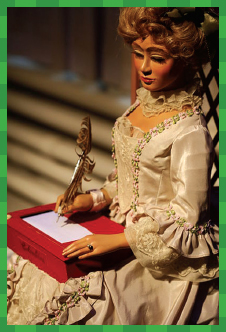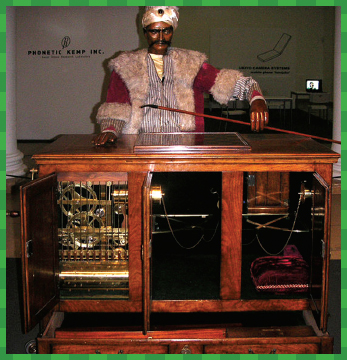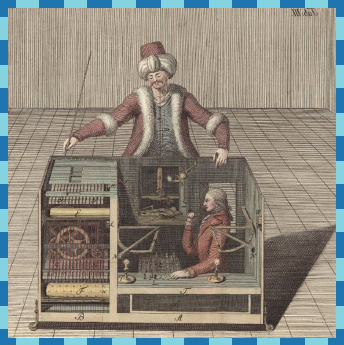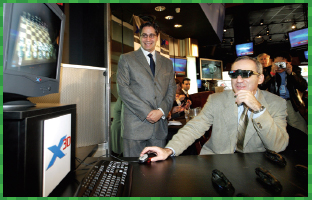
Chapter
12
The Turk
Practically the Terminator
Lived: Eighteenth to nineteenth century CE, Europe, America
Occupation: Chess-playing Automaton
A Whopper of a Lie
Automata were the dinosaurs of computers.
automata:
More than one robot.
They didn’t chomp on ferns (or other dinosaurs, if they were the carnivorous kind). Rather, they were an ancient type of robot. Some were even programmable—like a computer. Instead of doing complicated logarithms or downloading the latest app, they did the same thing over and over again.

Whatever you do, don’t imagine her coming to life at night.
Many told the time—you can call them clocks. Some were human-like and moved their arms or heads up and down, ensuring nightmares for life for little kids. Some used to amuse, like the mechanical duck that “digested” food and pooped it out. But maybe the greatest thing an automata ever did was help inspire two ginormous revolutions—the Industrial and the computer.
The Turk, a chess-playing automaton in the eighteenth and nineteenth centuries, was arguably the most famous automaton of all time. He traveled the world, fascinating kings, queens, scientists, and inventors. He was the inspiration behind some of the most important inventions in the history of human kind.
automaton:
One robot.
Only problem, he was a total fake. See if you can figure out the hoax of the Turk.
Anything You Can Do, I Can Do Better
Eighteenth-century European elites were used to being wooed. They had everyone kissing their aristocratic behinds, including all kinds of riff-raff who wanted their patronage (i.e., their money). So in order to impress them, inventors had to be impressive.
Wolfgang von Kempelen, inventor extraordinaire, never wanted to build the chess-player. He just wanted to be a scientist, but he picked a really bad time to stick his foot in his mouth. He did it in front of his queen.
During a performance by a French conjurer, Wolfgang leaned into Maria Theresa, Queen of Hungary and Bohemia, and Archduchess of Austria (not to mention Holy Roman Empress), and dismissively explained what he thought was going on—a loud show of noise, smoke, and mirrors with a few automata doing tricks his dog could do in his sleep. Kempelen claimed that he could do better. So the Queen told him to prove it. Kempelen’s mouth probably dropped to the floor, which would’ve made it easier to get his foot out.
She excused him from his court duties and told him to crack at it. She also told him he better not fail: this was a matter of national pride now. So Kempelen spent the next six months building his deceptive masterpiece.
red herrings:
Not actual fish, but distractions or fake outs to hide what’s really going on.
Throwing Red Fish
Every great magician knows that it’s imperative to throw a couple of red herrings at the audience to misdirect them. Luckily for Kempelen, he was a master performer. When he finally unveiled his automaton, he had the queen and everybody else at court eating out of the palm of his hand.
He told them that the Turk was more than a mere clockwork, wind-up automaton—he was an intelligent, fast-thinking, chess-playing marvel that could beat the pants off anyone in Europe.
First, Kempelen brought out his life-size automaton, which was a mechanical man who sat behind a huge wooden box looking very exotic and smoking a pipe (smoking was the cool kid thing to do in late eighteenth-century Europe). The automaton had dark skin and wore a turban and a tunic with bright billowing sleeves (during that time, exotic servants were also cool).
Kempelen announced to an intrigued audience that he had created an automaton that could play chess. That’s right! It didn’t need pre-determined moves like all the other automata out there. It could think for itself. (It was one step away from turning into the Terminator.)
In order to prove to his skeptical audience that there weren’t any children chess masters or dwarfs secretly hiding inside, Kempelen opened the box and stuck a candle inside. The audience saw some complicated machinery and the back wall. Positive that everyone believed it was empty except for clockwork, he then set up a chessboard, wound up the Turk, and asked for a victim . . . um . . . volunteer.

More exotic than chocolate—the other dark desire.
The Turk made the first move. He could pick up any piece and make any move, but that wasn’t all. If a player tried cheating, the Turk called him out on it. He’d pick up the offending move, put it back, and went ahead with his own turn, shaking his head sadly at the cheater. If the player tried cheating again, the Turk would clear the board with a sweep of his hand. After all, even robots have morals.
The Turk usually beat his opponent within half an hour. He took no prisoners. Not one to dally, he quickly blew through the Austrian court. The astonished queen insisted that Kempelen trot out the Turk whenever an important visitor came to Vienna to show off this amazing invention. She was bursting with national pride now.
You’d think Kempelen would have been thrilled. He had impressed the queen and fulfilled his promise. But he wasn’t happy at all. Devastated might describe it better. He wanted to be a scientist, not an inventor for the court’s entertainment. For a while, he tried pretending that the Turk was broken, but it didn’t work for long. Maria Theresa always seemed to see right through his bluffs. Finally, Queen Maria Theresa died and Kempelen dismantled the Turk—for good, he thought.
He was wrong.
Around Europe in Two Years
Soon after taking the throne, the new king, Joseph II, insisted that Kempelen bring the Turk out of retirement when Russian royalty came to court. This was exactly the sort of thing Kempelen didn’t want to be suckered into doing again, but you don’t say no to a king. Not if you enjoy keeping all your body parts.
Maybe Kempelen should have sabotaged the Turk during that performance, because it did such a good job of pummeling everyone into submission that King Joseph II insisted he show it off to the rest of Europe. A two-year vacation touring Europe doesn’t sound like the worst thing in the world to most people, but Kempelen wasn’t most people. He wanted to be taken seriously as a scientist, but when a king makes a request, it’s best to break out your passport.
playing:
This was considered an acceptable way to spend your time back when a person could make a living playing chess blindfolded.
Paris was a chess-playing hot spot, so Kempelen took his act there first. Chess masters sat around all day playing in cafes, so a giant automaton with a built-in table fit right in.
The Turk was a roaring success in the City of Lights. During Kempelen’s Parisian visit, many tried to discover the secret of the Turk, but they all failed. Kempelen was too crafty for those Frenchmen.
He never touched the Turk, except to wind him up every once in a while or to tap his fingers on the box as a distraction. Sometimes, just to prove how self-sufficient the Turk was, Kempelen hung out in the audience while the robot beat chess greats from all over the continent like a drum. Victorian Europe was baffled and bewitched. The Turk didn’t always win, but he won enough to make people suspicious of it and of Kempelen.
Theories about the Turk ranged from the absurd to the more absurd. It didn’t help when a chess-playing monkey turned up in Baghdad. One theory claimed that Kempelen had hired the monkey and slipped him inside the Turk’s sleeves with a few bananas to keep his chess master happy. (No monkeys were hurt [or even involved] in the making of this show.)
Some people insisted Kempelen used black magic to beat the chess players. Another popular theory was that dwarves were hidden inside the Turk. Others stuck to the more scientific line of reasoning, such as the use of magnets and machinery more complex than ever seen before. To disprove this theory, Kempelen allowed magnets to come close to the box. The Turk still won, so people decided it must be witchcraft after all.
By the time Kempelen and his invention arrived in London, no one had figured out the secret. Now, lowly commoners were able to try their luck against the machine, but still the Turk rarely lost. All the great thinkers of the day felt compelled to write about him, so there were tons of pamphlets and books circulating about the intelligent robot. He was more popular than sliced bread.
Creating a Masterpiece
Edgar Allen Poe’s poems could practically depress a puppy, they were so bleak. But before he started down the road to misery, he saw the Turk play in 1835. It inspired him to write an article debunking the mystery of the Turk.
Poe was dead wrong in his article, but that’s because he said the same things all the doubters before him had. The article did get Poe quite a bit of attention, though, and it helped him form his deductive skills. The format he used to write about the Turk would be used over and over again in his soon-to-be-famous mysteries like “The Murders in the Rue Morgue” where detectives used deductive skills to find the killer. So, did the Turk help create the first detective story? Maybe.
Finally, at the end of his two-year touring stint, Kempelen returned home and dismantled the Turk again. He planned on taking the secret of his invention to the grave. But the Turk, like the Terminator, had other plans.
I’ll Be Back
Johann Maelzel and the Turk were meant for each other. Both had panache, and both were good at tricking people. Maelzel knew this, and he tried hard to get Kempelen to realize this as well. Kempelen set a high price though, and Maelzel had to wait until Kempelen died. Luckily for both Maelzel and the Turk, Kempelen’s son just wanted to make a few francs and sold the chess-player for half the price his dad had asked.
It didn’t take long for Maelzel to rediscover the Turk’s secret and to breathe new life into his dusty parts after a twenty-year retirement. If it wasn’t for him, the Turk might have stayed in some stuffy Austrian attic for centuries more.
After adding a bit of flair to the Turk, like a voice box that would exclaim, “Echec!” (“Check!” in French), Maelzel also went on a tour of Europe—but he was actually excited about it. Maelzel would finally be able to rub shoulders with the cream of the crop, just like he knew he deserved. Europe would never know what hit ’em.
Napoleon, a notoriously poor loser in everything from games to wars, offered to play the newly refurbished chess-player. There are many differing accounts of the event (as there usually are in history) but in each one, Napoleon tried to cheat multiple times, forcing the Turk to sweep all the pieces off the board. (Some versions claim the chess pieces went flying due to the emperor overturning the table in rage at losing.)
Maelzel was tickled pink. Soon his automaton was the main act in a big show of metal moving parts. Maelzel himself became friends with the likes of Beethoven and French royalty. He had hit the big time. Well, sort of.
At one point, Maelzel had to flee Europe to escape debt collectors. But that ended up being Europe’s loss, because Maelzel left the continent, taking the automaton to America with him.
They swept through all the big East Coast American cities, inspiring both love and hatred among the people who faced off with the Turk. Along the way, they also influenced many people—and not just those interested in science.
Let’s take this to the battlefield, shall we?
Maelzel came across a young P. T. Barnum during one of the Turk’s exhibitions. He gave the kid some advice on how to use the press to attract more customers. Combining mystery, oddities, and showmanship into a spectacle was something at which the young Barnum excelled, being in the circus and all. Maelzel told him he was on the right track toward success, and today, the Ringling Bros. and Barnum and Bailey’s circus still draws the crowds, calling itself “The Greatest Show on Earth.” But that’s another story for another time.
Abracadabra!
So how did the Turk actually work? Like most magic tricks, the truth isn’t nearly as exciting as the trick. And like most magic, illusion is the key. The Turk wasn’t an intelligent, self-thinking automaton. In fact, he wasn’t an automaton at all. None of his mechanical clockwork parts moved his body, and he didn’t follow a set of predetermined steps. His arms moved by levers put in motion by the operator and he didn’t think for himself. The Turk couldn’t even tell you the time!
Not Just a Pretty Face
Kempelen did more than create the Turk. Once he finally got his way and went back to L.A.T (Life After Turk), he kept inventing things. He created an exploding steam engine (although the exploding part wasn’t planned), a typewriter for the blind, and a talking machine.
The talking machine that a young Alexander Graham Bell saw years later was a replica of Kempelen’s original. The sight inspired him and he invented his own talking machine. Today, we call it a telephone.
Maelzel also continued inventing, although he died aboard a ship next to the Turk, still deeply in love with it. Before his death, though, he created a portable metronome to keep the beat in music, an orchestrion (picture a robot orchestra), and a panharmonicon—an automaton that played military music.
Instead, the elaborate ritual of opening all of the doors and shining a light in the dark cabinet only helped mask what was really happening when the Turk went into action. A person, usually a chess master in on the secret, sat hidden inside the box.
Each time a new door was opened, the hidden chess master scooted to the opposite side on an oiled bench. The chess player didn’t even have to be child-sized; they just had to know when to bend and roll in order to stay out of sight.
chess master:
Kempelen figured out it was safer to approach a chess master, let him in on the secret, and have him be the operator than try to play against him, and probably lose.
The smoke from the operator’s candle went out through the Turk’s turban, and air holes were poked into the box. In the days before electricity, rooms were always smoke-filled, so no one noticed a little extra smoke hanging about the Turk like a halo. If the candle went out, the operator had a system worked out to notify Kempelen and, later, Maelzel. The box was still a dark, smoky place to hang out, so the shows were limited to an hour long. You know, so the operator wouldn’t pass out. That kind of thing would give the Turk away.

Not the actual inner workings.
Not everything about the Turk was fake, though. Those levers the Turk relied on to move his arm were quite creative, and there were magnets involved after all. Magnets were placed above the head of the operator inside the box, each one corresponding to a chess piece. When the opponent made a move, the magnets told the hidden chess master which pieces went where. (The magnets Kempelen and Maelzel allowed near the box did nothing to affect the ones inside due to their positioning.)
All of the machinery, creaks, and noises added to the mystique of a working automaton. In the end, people wanted to believe in the mystery, so they did. It wasn’t a bad thing, either, since it helped inspire not one, but two revolutions—the Industrial and the computer.
When Lying Is a Good Thing
Okay, so the Turk was a big fat fraud. At least he wasn’t taking over the world anytime soon. And even better, the chess-player inspired some real inventions that you would miss today.
While all those skeptics thought no machine could ever be capable of playing chess, another guy thought exactly the opposite. Charles Babbage had always been interested in mechanical objects. So he decided to challenge the Turk. Babbage was convinced that the Turk was a fake, but he thought such a machine was possible. It just needed the right, smart guy to figure it out. And he knew just the smart guy capable of making a robot play chess or checkers—himself.
Babbage got so excited about his own dream to build such a machine that he made himself sick. After a short vacation to help stop the vomiting and hives, he drew up plans for a machine that could think on its own, in a way. Many failures, bankruptcy, and sleepless nights later, Babbage created the forerunner to the modern computer.
It was this desire to imitate life that led to more mechanical developments and more complex machinery. The Industrial Revolution gained steam directly from the popularity of automatons. People started thinking, “Wouldn’t it be great if the robot got its hands rubbed raw from weaving instead of mine?” So they came up with cool inventions like the power loom to do all the grunt work.
Lessons from a Computer
It wasn’t until 1997 that a machine finally beat a human chess master. Soviet Garry Kasparov had beat a chess-playing computer called Deep Blue (as well as all those nerds who built him) in 1989 and then again in 1996. Confident he’d keep winning, Kasparov agreed to a third match in 1997. He figured it was his duty to protect the human race from intelligent computers of the chess-playing ilk.
Deeper Blue (the new computer) brought his thinking cap this time though—meaning he had his hardware upgraded. This allowed the computer to analyze two hundred million positions per second. The computer won, and Kasparov was stunned. He demanded a rematch, insisting Deeper Blue had cheated, but no dice. The creators quickly retired their creation and refused any more matches. That’s how to quit when you’re ahead.

Kasparov himself, not the least bit bitter.
In fact, the power loom—invented by Edmund Cartwright—was inspired by none other than the Turk himself, allegedly. Cartwright saw the Turk play in London (while it was touring with Kempelen) and thought it was terrific. Sure, he believed an automaton really was playing chess, but it allowed him to think if that was possible, anything was possible. We’ll forgive him this mistake, since it led to the power loom three years later and mass-produced Angry Bird t-shirts today.